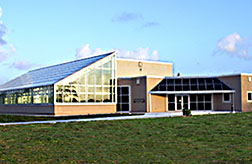This page has been archived and is being provided for reference purposes only. The page is no longer being updated, and therefore, links on the page may be invalid.
|
|
New Quarantine Facility Opens for Invasive Plant Research
By Alfredo FloresApril 8, 2005
DAVIE, Fla., April 8 – A quarantine research facility that opened here today will allow U.S. Department of Agriculture scientists and cooperators to safely work on solutions to some of south Florida's most devastating invasive weed and insect problems.
"This new quarantine facility will provide scientists with an invaluable resource to aid them in cooperative efforts to contain invasive species that threaten the Everglades and other environmentally sensitive areas in south Florida," said Edward B. Knipling, administrator of the Agricultural Research Service, USDA's chief in-house scientific research agency.
A dedication ceremony for the Invasive Plant Research Laboratory (IPRL) was attended by representatives of USDA, the U.S. Department of the Interior (DOI), the U.S. Army Corps of Engineers, the South Florida Water Management District, the Florida Department of Environmental Protection, the University of Florida's Institute of Food and Agricultural Sciences, state and local governments. Rep. E. Clay Shaw Jr. (Fla.) spoke, along with other invited guests.
In 2001, DOI provided $6.2 million to the Army Corps of Engineers for construction of the new facility, which is located at the University of Florida's Fort Lauderdale Research and Education Center. The IPRL will continue to be operated by ARS.
One invasive plant that scientists have targeted is Melaleuca quinquenervia. This non-native tree species from Australia was originally introduced in Florida in the mid-1880s. Since then it has quickly spread throughout south Florida, displacing native plant and animal communities, drying up wetlands, creating fire hazards and threatening the stability of the Everglades ecosystem. A cooperative endeavor called TAME Melaleuca, established by ARS in 2001, takes an areawide approach to managing this persistent pest on public and private lands.
Currently, IPRL scientists are directing studies of the melaleuca psyllid (Boreioglycaspis melaleucae), melaleuca weevil (Oxyops vitiosa), and the melaleuca gall fly (Fergusonina turneri). These three promising biological control agents may help curb or eradicate melaleuca.
Other potential biological control agents at various stages of development at the IPRL are aimed at battling Old World climbing fern, peppertree, giant salvinia, skunk vine and water hyacinth. The IPRL is also working on a biological control project to combat an invasive insect called lobate lac scale.
An open house was held at the new quarantine facility following today's dedication ceremony.


